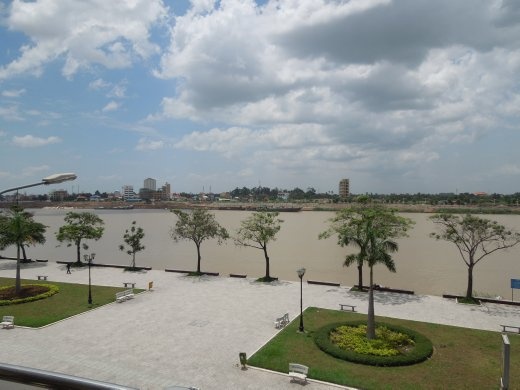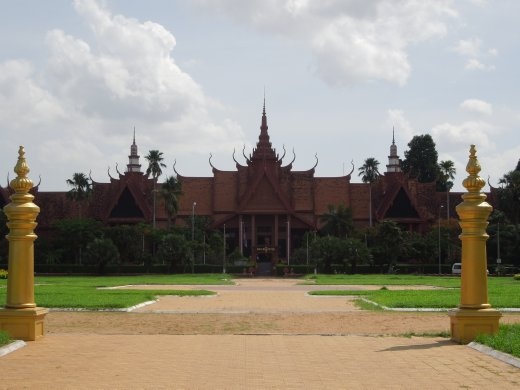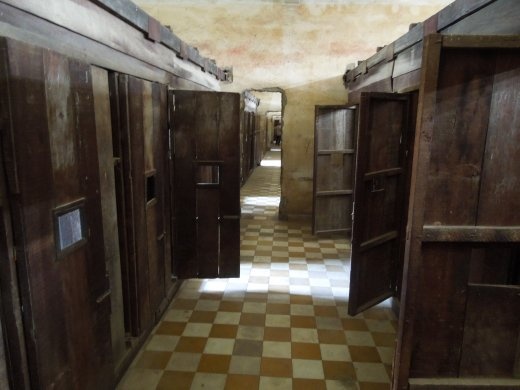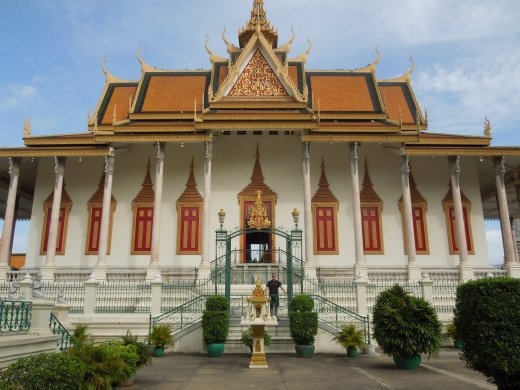Phnom Penh is a welcome contrast from Ho Chi Minh City. The pace is much slower, the people are a little friendlier, and surprisingly, everyone is much more used to foreigners. English is spoken everywhere here and unbeknownst to us the other "official" currency in Cambodia is the dollar! We were shocked to discover that ATMs dispense dollars instead of local Cambodian money- the riel- which is apparently non-exchangeable. Everything from hotels to meals was priced in dollars in addition to riels (4,000 riels = 1 dollar). Lunch for two was usually about 15-20,000 riels. Not too shabby.
We stayed in a simple but clean hotel by the riverfront, which is the area of town that caters more to Westerners. There are lots of restaurants, hotels, and bars (some of a shadier character judging on the scantily clad girls that hung around outside.) The whole riverfront has been developed into a park where locals and tourists come to play games, get exercise, or just hang out. We were even lucky enough to catch some fireworks one night that were apparently in honor of the Queen's birthday. The river is not much to look at, but it is nice for a stroll.

Tuk-tuks (Cambodian version of taxis) line the streets and we could not walk 5 feet in any direction without being called out to by a tuk-tuk driver hoping to score our business. They would actually sit outside our hotel lobby, waving at us through the windows to show us they were there if we needed them. In some respects it is nice knowing you will never get caught without a ride here but to be honest this got VERY old after the first 5 minutes of our getting to town.

The first big site we visited was the National Cambodian Museum. It's a beautiful building, right on the river, and was built during French colonial times (1920s). It has collections of ancient pottery, jewelry, bronzes, etc. as well as more modern collections of royal or otherwise important national artifacts that were saved from the Khmer Rouge destruction. It also houses the most important collection of sculptures recovered from ancient Khmer temples, especially the Angkor complex. Unfortunately we weren't allowed to take photographs of the artifacts (bummer!), just the museum building itself and its pretty courtyard. It was not a huge museum (all on 1 floor) but it definitely has an amazing collection. Most labels are translated into English and French and do a good job of providing contextual information. It felt like walking through one of the incredible museums in Italy, or even some of the halls in the Met, but instead of ancient Roman or Greek sculptures surrounding you it's ancient Khmer statues. Mostly buddhas, but there were plenty of shivas, ganeshas, vishnus, etc. (These temples swung back and forth balancing Buddhist and Hindu beliefs, depending on who was in charge at the time.) Our favorite sculpture was one of two giant monkeys wrestling. Everything in here was deemed too valuable or too fragile to leave to the mercy of throngs of tourists and potential looters out at the temples (still very much a problem today).

We also visited the Tol Sleung Museum, also known as S-21 Prison. This was a former high school that was turned into a prison and torture/execution facility by the Khmer Rouge during their 'reign of terror' from 1975 to 1979. It is a sad, dreary place, just like the concentration camps of Europe. The compound consisted of several buildings, each 2-3 stories, whose classrooms were converted into prison cells and torture chambers. Upon taking power the Khmer Rouge literally emptied out Phnom Penh-- forcing all of the residents out into the countryside for manual labor-- and began systematically purging Cambodia of its upper and middle classes. If you previously worked in any position of authority, politics, journalism, education, medicine, etc., if you spoke a foreign language, even if you wore glasses, you and your family were killed. In under 4 years, it is estimated that the Khmer Rouge killed approximately 2 million Cambodians, or about 20% of the country's population! Experts think about half of those were from executions, the other half from starvation and disease. Mass graves are still being discovered and there's not a single family that wasn't affected. Needless to say, this was all hard to wrap your head around. The Khmer Rouge, just like the Nazis, kept meticulous records of many of their actions and photographed all of the victims they 'processed' here. Being at this prison, looking at picture after picture of the victims was very upsetting. People from rural Cambodia still come here to try to see if they can identify missing family members among the photographs. Even after being exposed to some of the lowest possible limits of humanity through working at the Holocaust Museum we both felt the weight of this place and were saddened by its similarity.

On a lighter note, the last big site we visited in Phnom Penh was the Royal Palace complex. It is right across from the National Museum and is beautiful, peaceful, quiet-- everything palace grounds should be. A welcome change in scenery from the S21 prison. This palace and the Angkor Wat temples were some of the only sights spared by the Khmer Rouge in their sweep to wipe out anything prior to "year zero", as they called the start of their reign. You cannot actually go inside the Royal Palace- just look in at the throne room (which is huge and elaborately decorated and beautiful of course). We spent time walking around the grounds- lots of gardens, trees, little temples and shrines, walled courtyards with murals, monks walking around in their orange robes, and grounds workers making sure everything was spotless. We also went into the Silver Pagoda, so-called because its entire floor is laid with solid silver tiles, which kind of crunch under your feet. We didn't actually step on the tiles themselves- they've laid expensive persian rugs down over them for you to walk on instead (no shoes allowed of course)- but you could still feel them under the rugs. In one section they pulled back the rugs so you could see the tiles. This pagoda houses all the treasures of the royal family- gold, jewelry, bronzes, jades, etc. and is also famous for having a priceless baccharat crystal buddha statue as well as a life-sized solid gold buddha decorated with something like 10,000 diamonds. Yes, they were stunning. No, we were not allowed to take photos.

A final highlight of Phnom Penh were all of the NGO and non-profit organizations set up everywhere to help the impoverished people of Cambodia. Fair trade stores sell hand-crafted goods and artworks. Massage parlors train and employ blind people. Other places employ land mine victims. And many hotels and restaurants serve as training facilities for street children- getting them out of the gutters and teaching them skills like cooking and waiting tables, as well as English so that when they "graduate" they can get a job anywhere in the growing tourism industry. We ate at one of these training restaurants on our last night in town, and it was one of the best meals we've had so far on this trip! Warm artichoke dip, spinach and cheese "fritters", beef in pepper and onion sauce, and parmesan-encrusted chicken over a fresh ragu. Plus some strawberry-banana spring rolls with chocolate sauce for dessert. It was all so good it was gone before we remembered to take any pictures!